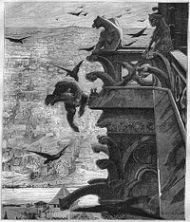“Hence arises the great power of the sublime, that, far from being produced by them, it anticipates our reasonings, and hurries us on by an irresistible force.”
Edmund Burke explains that fear and horror feed into the sublime. The raising of fear and horror in ones life increases their sublimity. Burke goes onto say in section II: “Indeed terror is in all cases whatsoever, either more openly or latently, the ruling principle of the sublime.” Fear is necessary for the sublime.
Taking the principals laid out by Burke one can compare it to the experience Adeline experiences in chapter 8 of The Romance of the Forest by Ann Radcliffe. In this excerpt Adeline goes out for a journey through the abbey. While on this journey Adeline comes face-to-face with the sensation of fear and excitement of what lies ahead. She grew in eagerness when she approached a room that would give her the answer to her suspicion.
Throughout this passage Radcliffe uses description to paint an incredibly vivid scene that even the reader can sense the fear through. Radcliffe reaches into the readers mind with her words and demands their connection to the novel, she evokes the feeling of fear within her readers. This idea relates to what Burke said: “The proper manner of conveying the affections of the mind from one to another is by words…”
Another author that wrote with the same vividness and idea of sublime related to Burke was Victor Hugo. Hugo defined sublime as a combination as the grotesque and the beautiful. Hugo wrote with a certain level of fear and horror that absorbed the reader. Hugo’s use of words were able to convey the message of the sublime similar to what Burke defined. To examples of Hugo’s use of fear and horror can be found in his poem Cromwell(1827), and in his novel Notre-dame de Paris (1831), (The Hunchback of Notre-Dame). And for those of you who are Disney fans let me warn you this was not a disney novel in any way. There are many more deaths in the original story and much, much more pain.
Spoiler alert here is a synopsis of the ending:
Esmerelda is accused of a murder and hung because of it. Frollo finds joy and laughter at this occurrence. Quasimodo pushes Frollo to his death off of Notre Dame and then lays next to Esmerelda’s corpse and dies there of starvation.
Not exactly the fairytale ending presented by Disney, but definitely something that highlights the ideas of Burke and the necessity of fear and horror on the path to the Sublime.

